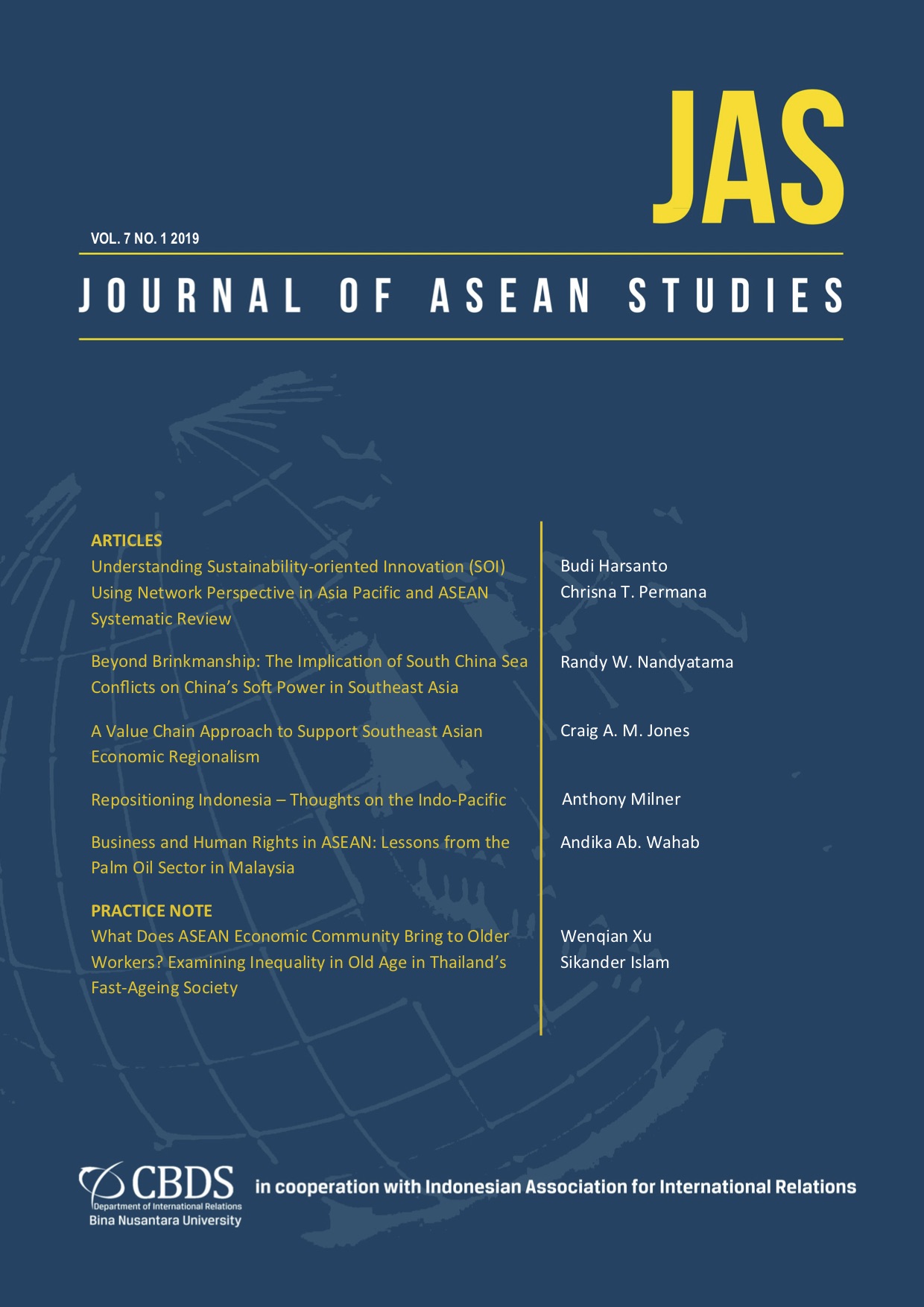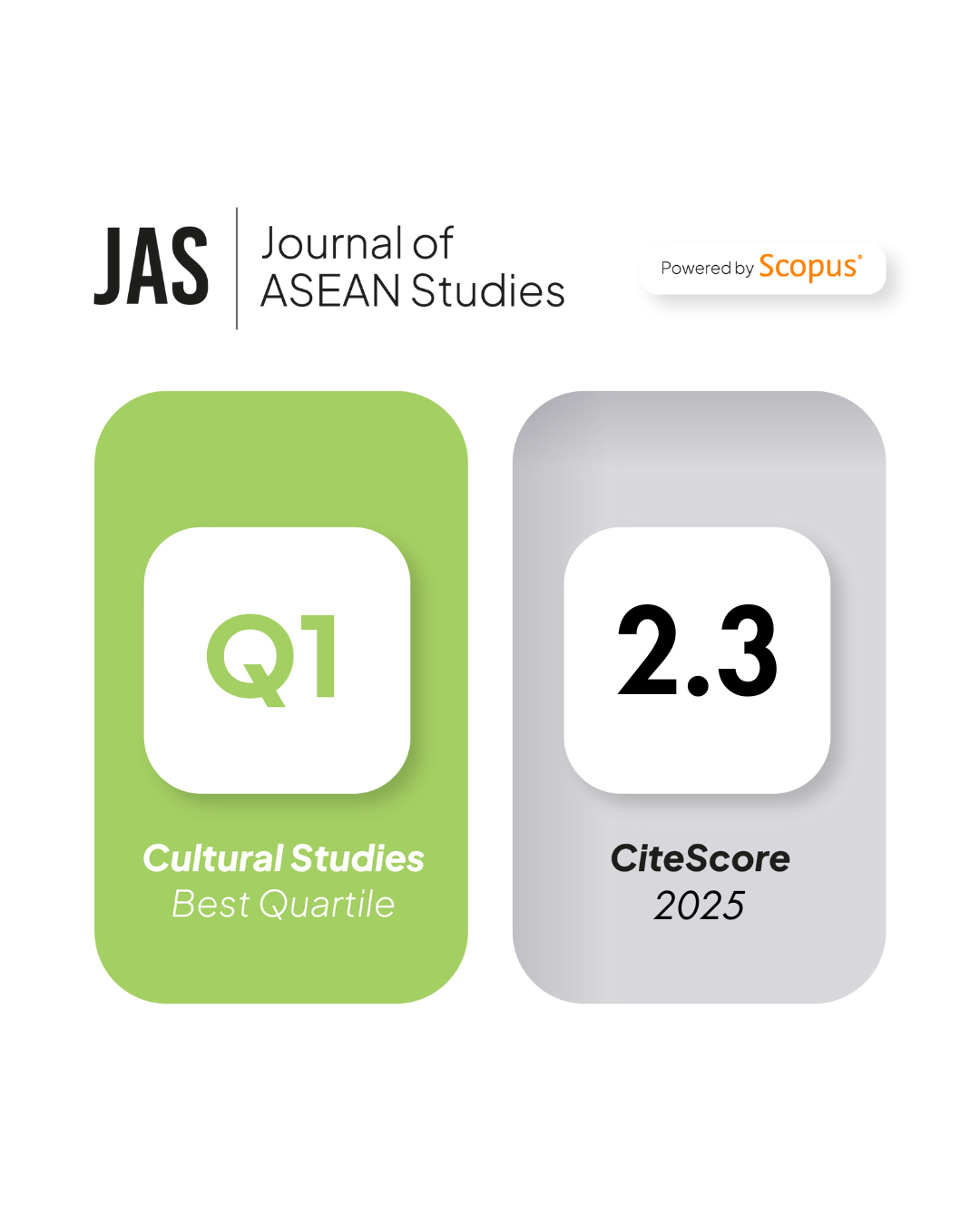Beyond Brinkmanship: The Implication of South China Sea Conflicts on China’s Soft Power in Southeast Asia
DOI:
https://doi.org/10.21512/jas.v7i1.5684Keywords:
China-Southeast Asia relations, soft power, threat perception.Abstract
While contemporary scholarly literatures on South China Sea conflicts have been dominated by hard power calculations, some other aspects remain under-researched. Rather underplayed in the existing literature is the question on the political implication of the conflicts on China’s soft power in the region. In responding to this issue, this article tries to carefully investigate the nature of the China’s soft power and the linkage between the increasing Chinese assertive measures in the South China Sea and the foundation of China’s soft power in the region. Through some cases of China’s skirmishes with Southeast Asian countries on the South China Sea between 2009 and 2012, this article argues that Beijing’s increasing hard power measures have induced growing threat perceptions in the region. This very context not only signals a distinct dissonance of Beijing’s image in Southeast Asia but also creates surging discontents and rejections to China’s role and political position in the region. Ultimately, China’s perceived inappropriate hard power measures affect its soft power, particularly in eroding the reputation of being a benign political entity as its source of soft power in Southeast Asia.
References
Acharya, A. (2003a). Seeking Security in the Dragon’s Shadow: China and Southeast Asia in the Emerging Asian Order. Institute of Defence and Strategic Studies Singapore’s Working Paper, 44, 1-27.
Acharya, A. (2003b). Will Asia’s Past be Its Future? International Security, 28(3), 149-164.
Agence France-Presse. (2011, June 9). Vietnam PM says sea sovereignty ‘incontestable’. Straits Times [online]. Retrieved January 19, 2012, from http://www. straitstimes.com/BreakingNews/SEAsia/Story/STIStory_677930.html.
Archick, K., Grimmett, R. F., & Kan, S. (2005). European Union’s Arms Embargo on China: Implications and Options for U.S. Policy. CRS Report for Congress. Retrieved January 19, 2012, from http:// www.fas.org/ sgp/crs/row/RL32870.pdf.
ASEAN. (2010). 43rd AMM/PMC/17th ARF VIETNAM 2010 Chairman’s Statement 17th ASEAN Regional Forum. ASEAN [online]. Retrieved January 9, 2019, from https://asean.org/?static_post=43rd-ammpmc17th-arf-vietnam-2010-chairman-s-statement-17th-asean-regional-forum-ha-noi-23-july-2010
The Jakarta Post. (2012, May 14). China to Enforce Fishing Ban in Disputed Waters. The Jakarta Post [online]. Retrieved January 9, 2019, from https://web.archive.org/web/ 20120517014221/http://www.thejakartapost.com/news/2012/05/14/china-enforce-fishing-ban-disputed-waters.html
Baldwin, D. A. (1999). Force, Fungibility, and Influence. Security Studies, 8(4), 173-183.
Banchard, B., & Mogato, M. (2012, November 29). Chinese Police Plan to Board Vessels in Disputed Seas. Reuters [online]. Retrieved January 9, 2019, from https://www.reuters.com/article/us-china-seas/chinese-police-plan-to-board-vessels-in-disputed-seas-idUSBRE8AS05E20121129
Banlaoi, R. C. (2010). Renewed Tensions and Continuing Maritime Security Dilemma in the South China Sea. In T. Thuy (ed.), The South China Sea: Cooperation for Regional Security and Development. Hanoi: Diplomatic Academy of Vietnam. 143-159.
BBC World Service Poll. (2011, March 27). Rising Concern about China’s Increasing Power: Global Poll. BBC World Service [online]. Retrieved January 19, 2012, from http://www. worldpublicopinion.org/pipa/pdf/mar11/BBCChina_Mar11_rpt.pdf.
Brahm, L. (2001). Introduction. In L. Brahm, China's Century: The Awakening of the Next Economic Powerhouse. Singapore: Wiley.
Calmes, J. (2011, November 19). Obama and Asian Leaders Confront China’s Premier. The New York Times [online]. Retrieved January 19, 2012, from http://www.nytimes.com/2011/11/20/world/asia/wen-jiabao-chinese-leader-shows-flexibility-after-meeting-obama.html?_r=1&pagewanted=all.
CNN. (2012, April 11). China, Philippines Locked in Naval Standoff. CNN [online], Retrieved January 92019, from https://edition.cnn.com/2012/04/11/world/asia/philippines-china-navalstandoff/index.html
Cho, I. H., & Park, S. H. (2013). The Rise of China and Varying Sentiments in Southeast Asia toward Great Powers. Strategic Studies Quarterly, 7(2), 69-92.
Chongkittavorn, K. (2011, June 7). Regional Neighbours See the Rise of China Differently. The Irrawaddy [online]. Retrieved January 19, 2012, from http://www.irrawaddy.org/ article.php?art_id=21442&page=2
Deng, Y. (2006). Reputation and the Security Dilemma: China Reacts to the China Threat Theory. In A. Johnston., & R. Ross, The New Directions in the Study of China’s Foreign Policy. Stanford: Stanford University Press.
Dupont, A., & Baker, C. (2014). East Asia's Maritime Disputes: Fishing in Troubled Waters. The Washington Quarterly, 37(1), 79-98.
Emmers, R. (2010). Geopolitics and Maritime Territorial Disputes in East Asia. New York: Routledge.
Emmerson, D. (2012, July 23). ASEAN Stumbles in Phnom Penh. East Asia Forum [online]. Retrieved January 6, 2019, from https://www.eastasiaforum.org/2012/07/23/asean-stumbles-in-phnom-penh-2/
Er, L.P., Narayanan, G., & Colin, D. (Eds). (2010). East Asia’s Relations with a Rising China. Seoul: Konrad Adenauer Stiftung.
Globescan. (2011, March 27). Rising Concern about China’s Increasing Power: Global Poll. Globescan [online]. Retrieved January 9, 2019, from https://globescan.com/rising-concern-about-chinas-increasing-power-global-poll/
Goh, E. (2007). Southeast Asian Perspectives on the China Challenge. The Journal of Strategic Studies, 30, 809-832.
Gomez, J. (2011, June 9) ‘China warns neighbours: Stop oil search in Spratlys’. Associated Press [online]. Retrieved January 19, 2012, from http://www.guardian.co.uk/ world/feedarticle/9687830.
Green, M., & Daniel, K. (2011). China's Hard Power and the Potential for Conflict in Asia. SERI Quarterly, 4(2), 32-41.
Guo, S., & Jean-Marc F. (Eds.). (2008). ‘Harmonious World’ and China’s New Foreign Policy. Lanham: Lexington Books.
Hall, T. (2010). An Unclear Attraction: A Critical Examination of Soft Power as an Analytical Category. The Chinese Journal of International Politics, 3(2), 189-211.
Huang, Y., & Sheng D. (2006). Dragon’s Underbelly: An Analysis of China’s Soft Power. East Asia, 23(4), 22-44.
Jamandre, T. (2011, June 3). China fired at Filipino fishermen in Jackson atoll, ABS-CBN Interactive [online]. Retrieved January 19, 2012, from http://ph.news.yahoo.com/ china-fired-filipino-fishermen-jackson-atoll-184604882.html.
Jayakumar, S. (2011). Key note address at the Conference on Joint Development and the South China Sea, Thursday, 16 June 2011, in Singapore. Singaporean MFA [online]. Retrieved 19 January 2012, from http://app.mfa.gov.sg/pr/read_content.asp? View,15634
Jones, D. M., & Smith, M. (2007). Constructing Communities: the Curious Case of East Asian regionalism. Review of International Studies, 33(1), 165-186.
Lampton, D. M. (2008). The Three Faces of Chinese Power: Might, Money and Minds. Berkeley: University of California Press.
Li, M. (2008). Security in the South China Sea: China’s Balancing Act and New Regional Dynamics. RSIS Working Paper, (149), 1-22.
Li, M. (2009). Soft Power: China’s Emerging Strategy in International Politics. Lanham: Lexington Books.
Li, M., & Dongmin L. (Eds.) (2011). China and East Asian Strategic Dynamics: The Shaping of a New Regional Order. Lanham: Lexington Books.
Lukes, S. (2005). Power: A Radical View (2nd ed.). New York: Palgrave Macmillan.
Kang, D. (2003). Getting Asia Wrong: The Need for New Analytical Frameworks. International Security, 27(4), 57-85.
Karim, M., & Tangguh, C. (2016). Waiting for Hard Balancing? Explaining Southeast Asia’s Balancing Behaviour towards China. European Journal of East Asian Studies, 15(1), 34-61.
Katzenstein, P. J., & Rudra, S. (2004). Rethinking Asian Security: A Case for Analytical Eclecticism. In J. J. Suh, Peter J. Katzenstein, A. Carlson (Eds.), Rethinking Security in East Asia. Stanford: Stanford University Press.
Khong, Y. F. (2004). Coping with Strategic Uncertainty: The Role of Institutions and Soft Balancing in Southeast Asia’s Post-Cold War Strategy. In J.J. Suh, Peter J. Katzenstein, A. Carlson (Eds.), Rethinking Security in East Asia: Identity, Power, and Efficiency. Stanford: Stanford University Press.
Krauthammer, C. (1995, July 31). Why We Must Contain China. Time [online]. Retrieved January 20, 2019, from http://content.time.com/time/magazine/article/0,9171, 983245,00.html
Kristof, N. D. (1998, November). The Problem with Memory. Foreign Affairs [online]. Retrieved January 19, 2012, from https://www.foreignaffairs.com/articles/asia/1998-11-01/problem-memory
Kurlantzick, J. (2007). Charm Offensive: How China’s Soft Power is Transforming the World. New Haven: Yale University Press.
Macikenaite, V. (2014). The Implications of China’s Fisheries Industry Regulation and Development for the South China Sea Dispute.
In D. Mierzejewski (Ed.), The Quandaries and Foreign Development (pp. 216-236). Poland: Wydawnictwo Uniwersytetu Åódzkiego.
Mearsheimer, J. (2001). The Tragedy of Great Power Politics. New York: W.W. Norton & Company.
Mogato, M. (2011, May 23). Philippines, China seek restraint in the South China Sea. Reuters [online]. Retrieved January 19, 2012, from http://in.reuters.com/article/2011/05/23/ idINIndia-57204920110523.
Nanto, D. K. (2008). East Asian Regional Architecture: New Economic and Security Arrangements and U.S. Policy. CRS Report for Congress [online]. Retrieved January 19, 2012, from http://www.fas.org/sgp/crs/row/RL33653.pdf.
Novotny, D. (2010). Torn between America and China: Elite perceptions and Indonesian Foreign Policy. Singapore: ISEAS.
Nye, J. S. Jr. (2002). The Paradox of American Power. New York: Oxford University Press.
Nye, J. S. Jr. (2004). Soft Power: The Means to Success in World Politics. New York: Public Affairs.
Ott, M. (2011). ASEAN and the South China Sea: A Security Framework under Siege. CSIS - the South China Sea Papers.
Pan, Z. (2008). China’s Changing Image of and Engagement in World Order. In S. Guo and Jean-Marc. F. Blanchard, ‘Harmonious World’ and China’s New Foreign Policy. Lanham: Lexinton Books.
Pazzibugan, D. Z. (2011, June 16). ‘Philippines pulls Spratlys ‘foreign’ posts’. Philippine Daily Inquirer [online]. Retrieved January 19, 2012, from http://newsinfo.inquirer.net/ 15230/philippines-pulls-spratlys-foreign-posts.
Percival, B. (2007). The Dragon Looks South: China and Southeast Asia in the New Century. Westport, Connecticut: Praeger Security International.
Pew Research Database. (2017). ‘China’, [Online]. Retrieved December 19, 2017, from https://www.pewglobal.org/topics/china/.
Rajagobal, N. (2016, July 12). The 2009 Claims that Changed the Dynamics in the South China Sea. The Strait Times [online]. Retrieved January 9, 2019, from https://www.straitstimes.com/opinion/the-2009-claims-that-changed-dynamics-in-the- s-china-sea.
Reyes, F. (2012, July 27). 3 Chinese government vessels spotted at Scarborough Shoal — DFA. Inquirer [online]. Retrieved January 9, 2019, from https://globalnation. inquirer.net/45761/3-chinese-government-vessels-spotted-at-scarborough-shoal-dfa.
Roy, D. (1996). The China Threat Issue: Major Arguments. Asian Survey, 38(8), 758-771.
Rozman, G. (2010). Chinese Strategic Thought toward Asia. New York: Palgrave Macmillan.
Senkar, O. (2004). The Chinese Century: The Rising Chinese Economy and Its Impact on the Global Economy, the Balance of Power, and Your Job. New Jersey: Prentice Hall.
Shirk, S. L. (2007). China: Fragile Superpower: How China's Internal Politics Could Derail Its Peaceful Rise. New York: Oxford University Press.
Storey, I. (2011a). Southeast Asia and the Rise of China: The Search for Security. New York: Routledge.
Storey, I. (2011b). Hardening Positions over Dangerous Grounds: Recent Developments in the South China Sea Dispute. CSIS [online]. Retrieved January 19, 2012, from https://www.csis.org/analysis/hardening-positions-over-dangerous-grounds-recent-developments-south-china-sea-dispute
Storey, I. (2013). Southeast Asia and the Rise of China: The Search for Security (1st ed.). London: Routledge.
Sutter, R. (2008). Chinese Foreign Relations: Power and Policy since the-Cold War. Lanham: Rowman and Littlefield Publisher.
Tang, S., Mingjiang, L., & Acharya, A. (Eds.). (2009). Living with China: Regional States and China through Crises and Turning Points. New York: Palgrave Macmillan.
Thayer, C. A. (2010). Recent Development in the South China Sea: Grounds for Cautious Optimism? RSIS Working Paper, (220).
The International Institute for Strategic Studies [IISS]. (2011). Report of 10th IISS Asia Security Summit [online]. Retrieved January 19, 2012, from http://www.iiss.org/ publications/conference-proceedings/shangri-la-dialogue-report-2011/
The State Council Information Office. (2006). ‘White Paper on China's Peaceful Development Road’. China Report, 42(215). Retrieved January 19, 2012, from http://chr. sagepub.com/cgi/reprint/42/2/215.
Thul, P. C., & Grudgings, S. (2012, July 13). SE Asia Meeting in Disarray over Sea Dispute with China. Reuters [online]. Retrieved January 9, 2019, from https://www.reuters.com/article/us-asean-summit/se-asia-meeting-in-disarray-over- sea-dispute-with-china-idUSBRE86C0BD20120713
Thuy, T. T. (2011, July 15). Recent Development in the South China Sea: From Declaration to Code of Conduct. East Sea Studies [online]. Retrieved January 9, 2019, from http://nghiencuubiendong.vn/en/conferences-and-seminars-/second-international- workshop/586-recent-development-in-the-south-china-sea-from-declaration-to-code- of-conduct-by-tran-truong-thuy
Tilman, R. O. (1984). The Enemy Beyond: External Threat Perceptions in the ASEAN Region. Singapore: ISEAS.
Wang, H. (2011). China’s Image Projection and Its Impact. In Wang Jian (Ed.), Soft Power in China: Public Diplomacy through Communication. New York: Palgrave Macmillan.
Wong, E. (2010, April 23). Chinese Military Seeks to Extend Its Naval Power. The New York Times [online]. Retrieved September 7, 2011, from http://www. nytimes.com/2010/04/24/world/asia/24navy.html?pagewanted=all
Yan, X. (2006). The Rise of China and Its Power Status. The Chinese Journal of International Politics, 1(1), 5-33.
Zheng, B. (2005). China’s Peaceful Rise: Speech of Zheng Bijian 1997-2005. Washington DC: Brookings Institution Press.






















